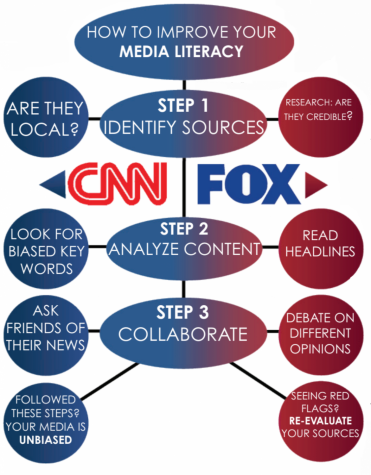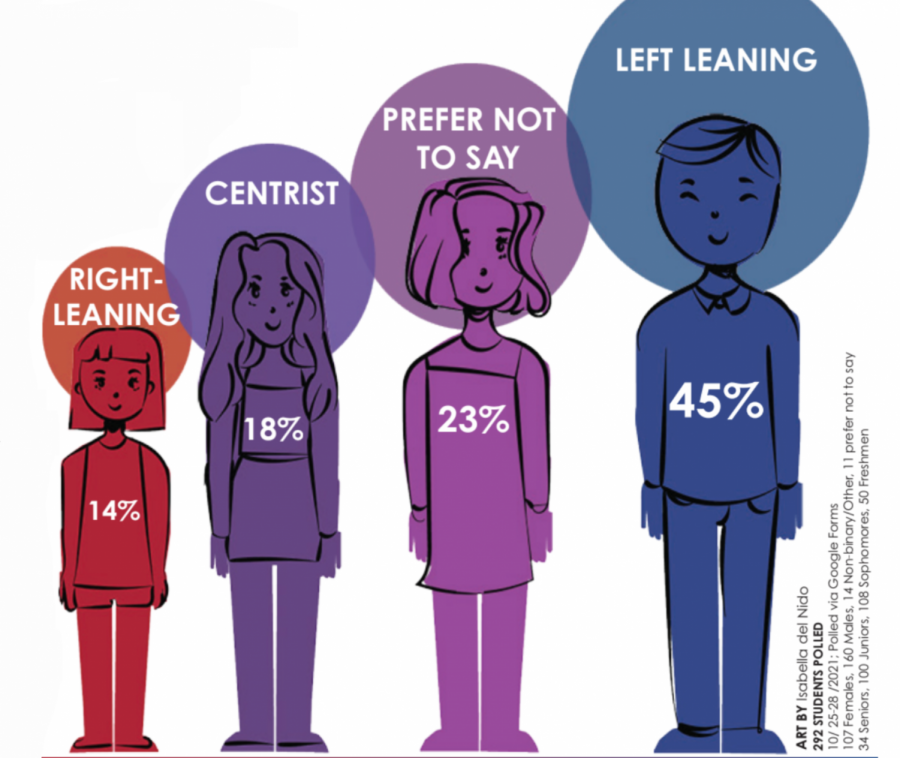Digital credibility crucial for Gen-Z
According to a recent poll, the majority of Bowie students are politically left-leaning.
November 25, 2021
Senior Brodi Tokar checked his phone one winter afternoon, immediately his phone was filled with notifications from different news outlets; something had happened at the United States Capitol involving outgoing president Donald Trump supporters and Capitol police regarding the outcome of the 2020 presidential election.
From CNN, he noticed coverage on the extremity of the extent the rioters went to to prove their point, while from FOX, their articles pleaded with viewers to acknowledge the protesters’ frustration and therefore justified their actions.
The difference in the stories coming out confused Tokar. He wondered which side was telling the right side, the factual side of the incident. He wasn’t sure where to look for an unbiased reporting of the riots, a reality for many Americans reading or listening to the news.
“Finding accurate news is hard nowadays because there always seems to be biases within everything you read,” Tokar said.
There are a magnitude of ways to obtain news, such as social media sites, television broadcasting, candidate rallies, and paper newspapers. In recent decades, the expansion of technology has led to the polarization of media, and therefore many sources being biased to one political side. Even so, there are steps students can take along a path to find unbiased media and information sources.
Political blogger Andrew Blotky provides tips to people on how to read news efficiently. He aims to help people consume informational media to better protect individuals’ rights as voting citizens.
“Regardless of your political persuasion, part of being an effective communicator, leader, and citizen means being a better consumer of news and information,” Blotky said in an article from Medium. “Taking control of what you consume and where you consume it is something we can all do a little better and a lot more often.”
For children and teenagers the prominent media source that is played by their parents in their homes is what guides them the most, according to political scientist Jeffrey Lyons. In a study, he reported that roughly three-fourths of children grow up to share the political views passed down to them from their parents, and that this makes it much more difficult for them to create independent views.
“I definitely think my parents’ political views influenced me because it’s the first thing I hear in my house and over time it’s impacted the way I think,” Tokar said. “Then again, as I’ve gotten older, my views have become a bit more independent from theirs because as I grow I can find my own news and make views for myself.”
A tip mentioned on Blotky’s blog for consuming unbiased information is to strictly discriminate sources between facts and opinions. He claims that even those uneducated on politics have the power to distinguish between the two and ingest media based on that. Government and politics teacher Dalton Pool claims that the distinction between facts and opinions being clear is very important when ingesting news.
“As long as you know somebody’s opinion, then that’s fair; separating facts from opinions is the biggest challenge when reading news, and that honestly just takes a lot of practice,” Pool said. “It also takes looking at a variety of sources, and usually they’re required anyway to say whether its category is news or opinion, but it can be hidden in the headline or byline as well.”
With this said, Tokar concedes that focusing on fairness in sources, rather than a complete erasure of bias, is also effective in gaining information because of the plethora of bias in all forms of media in the past few decades.
“I would rather find my news from somewhere completely not biased, but honestly it’s very hard to get unbiased news nowadays because so many sources are biased somehow,” Tokar said. “My parents will either be on Fox News or ABC News, which are both biased towards different directions; I’m sure there’s platforms that aren’t biased, but it seems that everywhere I look has some sort of lean to it.”
When beginning to search for informational sources, evaluating the source carefully through background research before reading the article given by them will give one a better understanding of its credibility, according to an article by the University of Tennessee. The article also mentions a site, AllSides, which provides information and statistics on the bias of specific sources people get their news from, in order to adequately determine how accurate the news is. Chambers has used this site and branched off of it into other sources she feels are reliable as well.
“I usually try to get my news from unbiased sources, such as The Associated Press, NPR, and CBS because these are all reliable sources that are known to be almost completely unbiased, yet are all very informative on issues that we as a society are presented with,” Chambers said. “BBC is also another reliable source for more global controversies.”
Once the sources have been identified, another tip given by the University of Tennessee is to dissect words and phrases in the articles for hints of bias towards a political side. Their site provides a quote investigator that can identify keywords in media sources and decipher their potential biases. Chambers also has methods for identifying whether or not a source has biases in their articles.
“Almost every time you read an article or news site that leans either way on the political spectrum, you can tell which side they favor,” Chambers said. “For example, more liberal news sites almost always use “immigrants,” whereas more conservative sites usually always say “illegals” or other derogatory terms to describe those coming into the United States; another example is the use of COVID-19 by liberals or those who lean left to describe what the pandemic was caused by, whereas conservatives will use words such as hoax.”
In addition to specific words, another stressor Tokar notices when identifying sources and depicting their credibility is the targeting at parties or politicians hinted at by certain sources or articles.
“It’s the diction that they use, definitely derogatory, towards a certain party or a politician that makes me see its bias,” Tokar said. “Certain slang that they use is obvious regarding how they speak upon others; it’s a little different towards different people like they’ll praise some people, but then play down or talk bad on other people, and then I can obviously see which side they lean towards.”
Even before reading the article and identifying biases within it, Pool catches immediate biases in a story or on a source that help determine whether or not he wants to continue reading or listening to them.
“The quickest way to pick up is headline, which are usually phrased in questions that try to make it more dramatic, almost treating it like a sports event or entertainment instead of news,” Pool said. “You can tell a lot about the story from its headline, and usually if the headline is biased, the story will also start with a lot of opinions, rather than facts showing both sides of the conflict.”
Another step to learning from the media is sharing information with friends and family to get their input on certain topics and have mindful conversations about them, according to a collaborative learning article from Dartmouth University by Barbara Knauff.
“Collaboration helps students develop a sense of audience, and gives them practice in analyzing writing,” Knauff said in the article. “Collaborative exercises work best when they are given multiple points of view.”
For Pool, communicating with friends and family on media sources is important for him when digesting news and expanding his view of information regarding it.

“Sometimes, I’ll share an interesting story with family or friends, but I fall victim to what a lot of Americans do, which is that my friends and family usually side with me regarding a lot of political issues,” Pool said. “With this said, I also don’t shy away from mindful conversations; if something’s in the news, my wife and I will discuss it, and I think that’s one of the most important things, especially citing your sources when you are talking about it with people.”
On the other hand, digesting politics individually and analyzing the stories read is also helpful for Tokar before bringing the conversation of global issues to talk about with friends.
“I feel like I kind of keep it to myself if it’s not a global issue because talking about politics with people can be a slippery slope these days,” Tokar said. “Of course, on big issues like the capitol riots, I immediately told my friends about it because everyone was talking about it; I think it really depends on the significance of the issue, but if it’s important, collaboration helps everyone better understand and digest what’s happening around us in the world because talking about things always helps.”
In the Dartmouth article, Knauff claims that collaboration also helps students understand writing as a public act they can share with each other, rather than one that isolates them and that they should digest alone. For Chambers, sharing politics with her friends and family allows her to be more comfortable sharing her own views.
“Most often, the news in which I read is then discussed with my family, and I tell them about what I learned in news; I enjoy hearing my family’s differing or agreeing viewpoints to mine, because talking to them gives me an outlet to share my opinions, too,” Chambers said. “If I communicate the news that I read with my friends, it sometimes will be delivered in a biased fashion, as my friends and I stand on the same side.”
Beyond examining for blatant biases in media and avoiding them completely, Pool tries to acknowledge biases in sources and learn from them as well, even while trying to read from places that are as information-based as possible.
“I know that all sources are not completely unbiased, so our goal shouldn’t be to seek out sources with no bias because there is no perfect source, so we should look for fair sources; I advocate for a diversity and a variety of sources,” Pool said. “Our goal should be to understand bias within everything and as we’re consuming it, see the bias that’s in there and take it into account because even biased sources can be very helpful; opinions are okay at times, we just need to be able to see them.”










